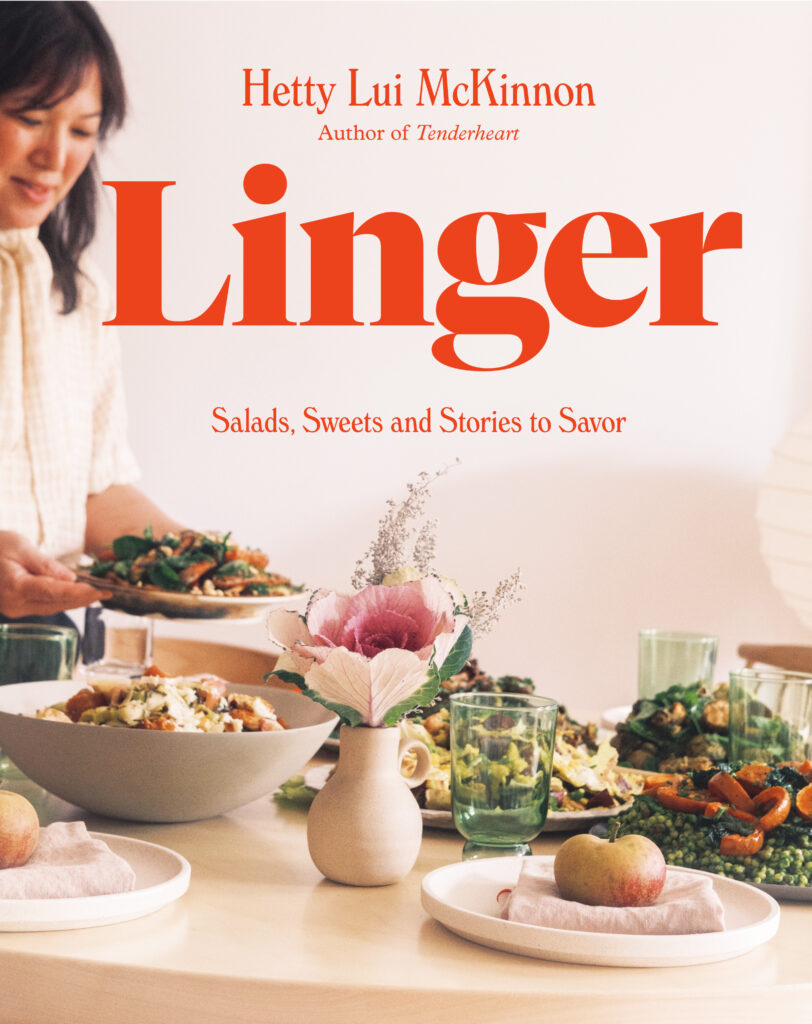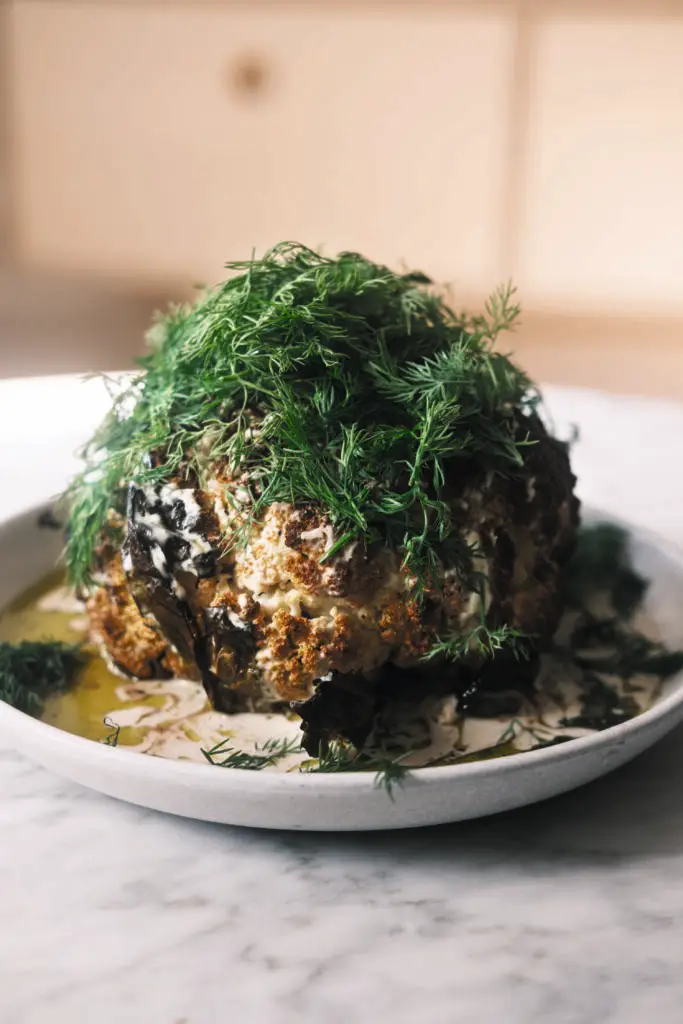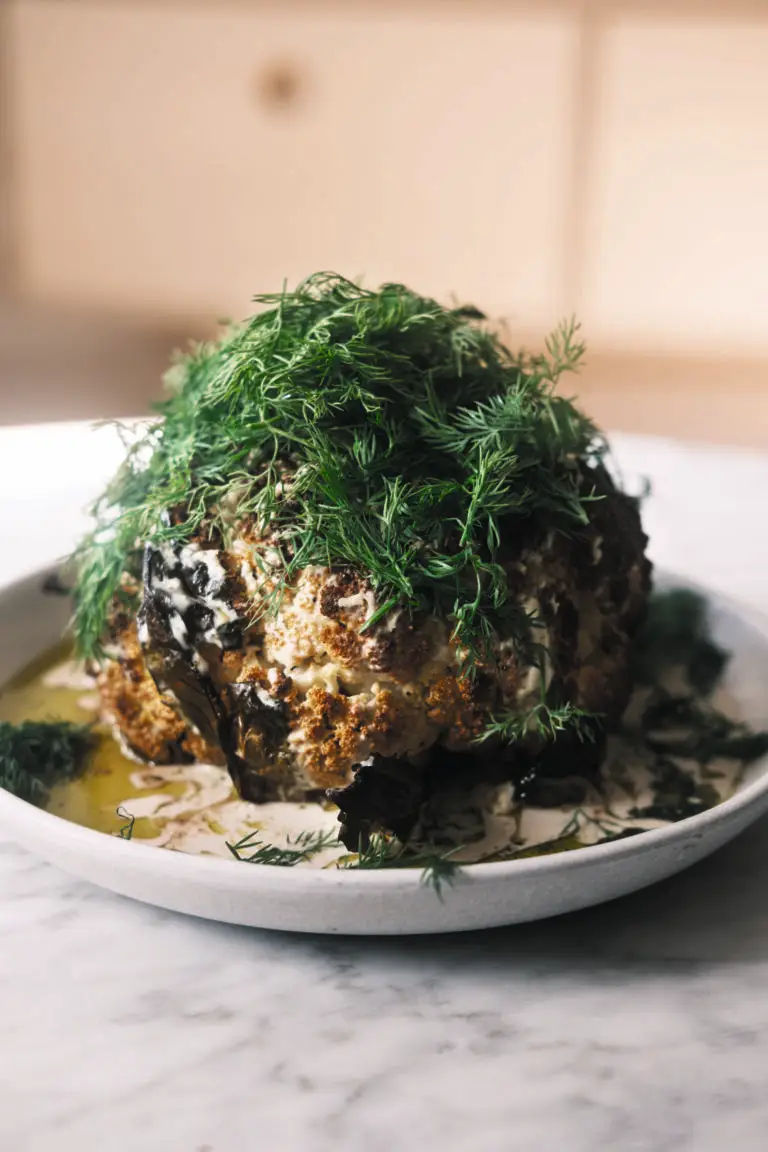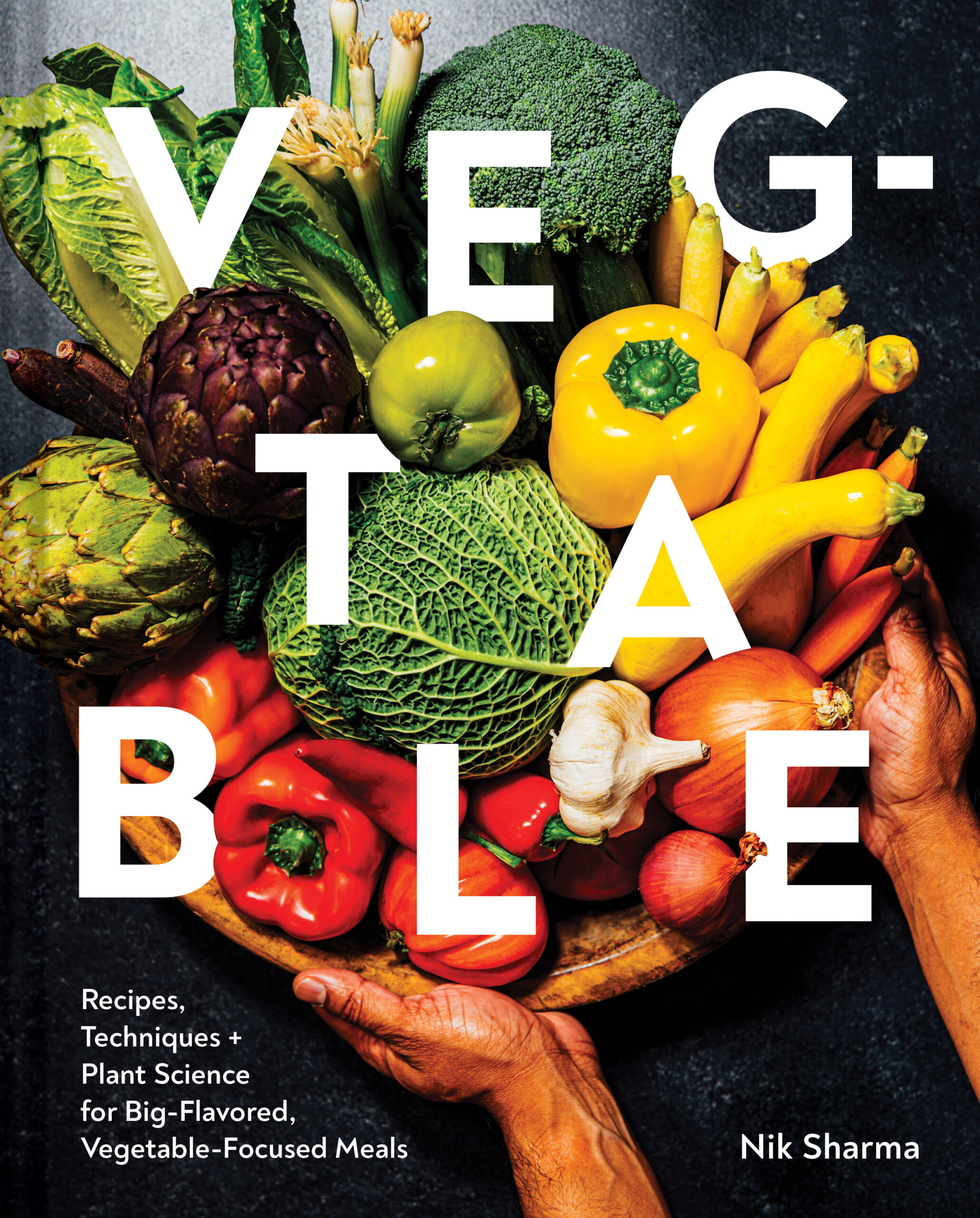

WHOLE ROASTED CAULIFLOWER WITH A MOUNTAIN OF DILL: SIMPLE, BOLD, AND TRANSFORMATIVE
Whole roasted cauliflower has become one of the iconic vegetable dishes of the last decade. What makes it so appealing is its ability to feel both dramatic and comforting at the same time. One humble head of cauliflower, with little more than olive oil, salt, and oven heat, is transformed into something golden, nutty, and celebratory.
In Linger: Salads, Sweets and Stories to Savor (Amazon/Bookshop), Hetty Lui McKinnon takes this global trend and gives it her own inspired twist. She borrows flavor cues from Agi’s Counter, a Brooklyn restaurant known for its Eastern European–influenced cooking, where dill oil and fresh dill crown “green devil” deviled eggs. Hetty applies this same idea to cauliflower, pairing the sweet, caramelized brassica with tahini, a drizzle of chile oil, and a mountain of dill that makes the dish unforgettable.
THE ROOTS OF WHOLE ROASTED CAULIFLOWER
Roasting an entire cauliflower may feel modern, but the idea has roots in Middle Eastern cooking, where brassicas are often roasted, fried, or braised until meltingly soft and then finished with herbs, tahini, or yogurt. What makes the whole head preparation special is the contrast in textures: a crisp, charred exterior giving way to a creamy, almost custard-like interior.
By borrowing inspiration from Eastern European flavors, dill, garlic, lemon, and hot sauce, Hetty’s version becomes both familiar and surprising. It’s a dish that speaks to her cooking philosophy: celebrating vegetables by giving them the stage usually reserved for meat.
WHAT MAKES HETTY’S VERSION SPECIAL
- Minimal prep, maximum payoff: Unlike breaking cauliflower into florets, roasting it whole requires almost no knife work.
- Tahini dressing: Nutty, creamy, and tangy, it ties the dish together while echoing flavors of the Levant.
- Optional dill oil: A cheffy but simple infusion that heightens dill’s aromatic brightness.
- The dill mountain: More than a garnish, this is the recipe’s central move. Dill’s volatile compounds—carvone (shared with caraway) and limonene (also in citrus)—add freshness and lift, countering cauliflower’s earthy depth.
THE SCIENCE OF ROASTING CAULIFLOWER
Cauliflower, like other brassicas, contains sulfur compounds that can taste sharp when raw. High oven heat triggers Maillard reactions on the outer surface, creating nutty, toasty flavors, while slow caramelization of its natural sugars builds sweetness. Meanwhile, steam trapped inside the dense core tenderizes the interior. This dual process is why whole roasted cauliflower tastes both robust and delicate at once.
Pairing it with dill adds an aromatic contrast: dill’s bright, grassy terpenes play against the roasted brassica’s deep umami, creating harmony through opposition.
HOW TO SERVE IT
Hetty’s roasted cauliflower works beautifully as:
- A centerpiece on a vegetarian table, drizzled with tahini and chile oil.
- A side to roast meats, where its acidity and freshness cut richness.
- A shared dish at a dinner party, carved at the table for dramatic effect.
Serve with warm flatbreads, a cucumber salad, or simply on its own with extra lemon wedges.
A DISH THAT LINGERS
This cauliflower embodies adaptation and reinvention: Middle Eastern roasting techniques, Eastern European dill, and Hetty’s own Australian-Chinese-American lens all converge in one striking yet straightforward recipe.
If you’re looking for a dish that elevates a single vegetable into a centerpiece, this one delivers.
LINGER: SALADS, SWEETS AND STORIES TO SAVOR
If this recipe resonates with you, I highly recommend picking up Hetty Lui McKinnon’s Linger (Amazon/Bookshop). It’s filled with dishes that encourage slowing down, savoring the moment, and celebrating vegetables with warmth and generosity.
Print
Hetty McKinnon’s Whole Roasted Cauliflower with a Mountain of Dill
5 Stars 4 Stars 3 Stars 2 Stars 1 Star
No reviews
The inspiration for this whole roasted cauliflower comes from an unlikely source—the “green devils” at Agi’s Counter, a Brooklyn restaurant that serves “market-driven cuisine with heavy Jewish; Eastern European influence.” Their green devils are actually deviled eggs, topped with dill oil, a heap of fresh dill, and optional-but-not-optional hot sauce. It is a spectacular mouthful. I took elements of this dish and applied it to a whole roasted cauliflower, one of my favorite ways of cooking this sweet brassica. While it takes longer than roasting florets, this recipe requires virtually no preparation, and I love how charred and crispy the cauliflower exterior gets while the interior stays soft and creamy. The dill oil is a cheffy move, I admit, but it is pleasingly refined, almost like a dill-infused essence that rains magic over the dish (you can absolutely skip this part of the recipe if you like). Of course, the whole cauliflower is then buried under a mountain of fresh dill, which is absolutely mandatory because dill is the power move that makes this dish unforgettable.
From Linger: Salads, Sweets and Stories to Savor © 2025 by Hetty Lui McKinnon. Excerpted by permission of Alfred A. Knopf, a division of Penguin Random House LLC. All rights reserved. No part of this excerpt may be reproduced or reprinted without the publisher’s written permission.
- Yield: 4
Ingredients
1 head cauliflower [2 lb/900g]
Sea salt and black pepper
1/4 cup [60 g] tahini
1 garlic clove, grated
1 tablespoon lemon juice (from 1/2 small lemon)
1 cup fresh dill leaves
Hot sauce or chile oil
Dill oil (optional)
1 cup fresh dill leaves
1/3 cup [80 ml] extra-virgin olive oil
Instructions
- If you’re making the dill oil, in a small food processor or high-speed blender, place the dill and oil and blend until the mixture is as smooth as you can get it. Transfer the mixture to a jar and set aside at room temperature for 2 hours (or overnight in the fridge). Strain the mixture through a cheesecloth or a very fine sieve, squeezing the cloth or pressing down on the dill with the back of a spoon to extract as much oil as possible. Transfer the oil to a jar and discard the dill sediment.
- Preheat the oven to 425°F (225°C).
- Remove the outer leaves from the cauliflower and trim the stem so it can sit flat. Place the cauliflower on a baking sheet, drizzle with olive oil and season well with salt and pepper. Toss to coat well. Roast until the cauliflower is golden and tender all the way through, 50 to 70 minutes (the exact cooking time will depend on the size of your cauliflower, so check regularly). You can test by inserting a bamboo skewer through the center core; if it goes in easily, it is ready.
- In a small bowl, combine the tahini, garlic and lemon juice with about 3 tablespoons water and whisk until smooth and a pourable consistency. Season with 1/2 teaspoon salt and a big pinch of pepper.
- To serve, drizzle the tahini all over the cauliflower, and add drops of the dill oil, if using (use as much or as little as you like). Top with the dill leaves and a few drops of hot sauce or chile oil.

